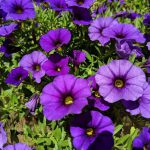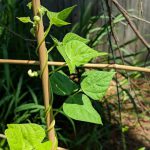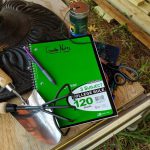Need an extra brain to keep all that gardening information up to date? Master Gardener Amanda Mae Larsen (amandamae28@gmail.com) has tips on how to keep a garden journal so that you know exactly what variety of blueberry you’re growing in your yard, and when pests started munching on it last year. You can read more of Amanda’s articles [here].
Remembering on Paper: How to Keep a Garden Journal
Because of Pinterest and the “inspiring” places like it, the term journaling might bring to mind artful pages filled with words and inspiring images… pages as beautiful as they are daunting. I’m not going to lie, I went to school for art, but those beautiful pages scare the daylights out of me. At the moment we’re in the thick of the spring growing season in Florida, and I KNOW don’t have the time or the energy to put that much work into beautiful pages. I can barely keep up with crushing the latest clutch of Lubber spawn (that’s Romalea microptera, for you insect nerds) under my boot heel, let alone sit down with watercolors and calligraphy pens to make a pretty note about the way my plants make me feel. I do, however, make time to take NOTES.
Art and Science have a stunning amount of things in common. They’re both about observing what goes on around you, and translating it into information to pass on to others (or just future you). One of the things I took away from my art and design classes in college was to take note of the things around me with an eye on what might be useful for future projects. This is more boring than you would think, but also infinitely useful when it comes to organizing information into usable forms that WILL make your life easier later.
I’ve been sitting with trying to figure out what my journal process is for the garden, and I’ve distilled it down to these rules:
1. Be thorough, but brief

Being thorough doesn’t mean being long-winded. Anything I can do to make a thorough job fast, I do. I staple and tape empty seed packets to the pages, take quick notes about my different garden sections while I’m out in them if I notice something out of the ordinary, or if I add a new plant, or fertilize. I note when a particularly nasty pest hatches out (I’m looking at you, lubbers and hornworms), write in particularly out of the ordinary weather occurrences. I write down which plants went into which beds, when, and where I got them from (business cards get taped in there too, when I remember to grab them).
I try to use scientific names where I can, to make it easier for future me to google information about the care of those plants when something, inevitably, goes awry. Rarely are these notes more than four or five words and a date, but that little bit of information goes a long way when I need to look up what the heck kind of tomatoes went into bed #2 last year, or when I forget the last time I fertilized the rosemary.
2. Include the DATE

I really can’t stress enough about putting down a date to things. If you have any plans to keep your garden going for years to come… take dated notes. Noticing yearly patterns and trends is tremendously valuable to a gardener. The more data you have about when you started planting in spring, how the summer storms effected your plants, your biggest autumn harvest days, and when the winter frosts came to kill your tender tropicals— the better you’re going to be at this rewarding past-time the next year. And boy, will it have you learning from your mistakes. In fact, when and why a plant dies might be the most useful information in your book.
3. Set a specific time/ triggering event to record things
My time to write down my notes is just after I finish a walkabout in my garden, or when I set up to put in a new plant. I take the book out with me, set it on my gardening table, do my walk/ put the plant in, come back to sit and take a few notes about what I just saw/did. Doing my biweekly walk-around is my most numerous triggering event. I’d prefer to have a specific day to sit down and just record everything that went on that week, but I have a hectic schedule. If you have a schedule that allows it, you should set an alarm on a specific day, at a specific time, that tells you to write down all the garden goings-on in your book. Or, like me, just do it every time you do a certain thing for the garden. It becomes habit after a while, and it’s a useful thing to do habitually.
4. Write legibly
In a perfect world, I wouldn’t have to say to be legible when you write. This isn’t a perfect world. My chicken scratch is HORRIBLE to read if I’m not careful. Know thyself. If you got brilliant marks in penmanship in school, good for you! But if you’re me and you can’t read your hieroglyphs if you abandon them and come back in five minutes… maybe take a bit more time in making sure you can use the records your taking.
5. Utility is key, pretty is a bonus

My garden journal is a boring, spiral-bound, college-ruled notebook. My journal is not pretty, not particularly inspiring, and not much to look at… but the information I’m storing there is some of the most useful stuff I’ve ever taken the time to record. It’s so important to get a sense of the land you inhabit— of it’s seasons and creatures, and the things you bring into it. Of course, there’s nothing wrong with a gorgeous journal full of inspiring thoughts about your garden, and if you want to keep one like that GO FOR IT!
I’m just on the side of practicality, and I’d much rather see you taking the down and dirty notes that will make your garden THRIVE in years to come from your accrued knowledge than worrying over which ink color you should use today. I know if I had some big, artistic, grand plan for my journal that I probably wouldn’t be keeping one. I’d probably be sitting here thinking about how great this blank sketchbook is going to look when I get around to decorating it… Oh, shoot, from what vendor did I get that blueberry bush that did so well last year? What cultivar was it anyway? Dang, I knew I should have kept that tag somewhere…
My garden journal is my memory of the little things that make a garden grow… and all the plants I killed, so I don’t do it that way again. It makes me remember last year, plan this year, and look forward to the next. It has the name of that obscure nursery vendor I met at a Buddhist temple in Tampa where I got that really cool Gynura procumbens. It keeps the memory how Irma ripped my Ethiopian eggplant to shreds, and how healthy and covered in ladybugs and lizards it was before the storm, and because I know where I got it from, I can get another one and put it someplace safer from the wind than where I had it before. Keeping this unassuming notebook up to date is one of the best things I do for my garden— which makes it one of the best things I do for me.
Contact the Plant Clinic
The Seminole County Master Gardener Plant Clinic is open Monday – Friday from 9am-Noon and 1pm-4pm. For more information on how to contact a Master Gardener about your gardening questions, visit our website at this [LINK].
 1
1
